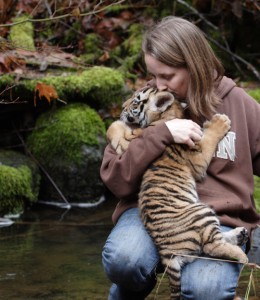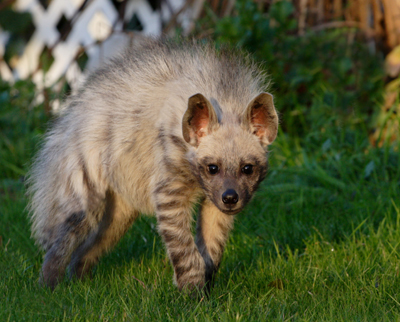 We have been caring for a young Bengal tiger named Titan. He was 8 weeks old and 15 pounds when he arrived, and around 22 pounds eight days later. He has around 500 pounds still to gain. He is on his way to a new and exciting life, and is here for some additional socialization. We are quite fortunate to have some wonderful colleagues who sometimes send animals here which allows us to keep learning and experiencing new individuals, and benefits the animals by exposing them to new experiences with trainers who are good at showing them that the world is a wonderful place. While with us, Titan will get to meet a wide variety of “other” animals and have different experiences. One aspect of training animals for film is that a wide variety of animals either live here or have visited, so all of our animals are quite welcoming towards visiting creatures. Last summer we had a baby camel in the kitchen and I opened the door to let the dogs say hello, and they walked right past her as though a camel in the kitchen was utterly expected…
We have been caring for a young Bengal tiger named Titan. He was 8 weeks old and 15 pounds when he arrived, and around 22 pounds eight days later. He has around 500 pounds still to gain. He is on his way to a new and exciting life, and is here for some additional socialization. We are quite fortunate to have some wonderful colleagues who sometimes send animals here which allows us to keep learning and experiencing new individuals, and benefits the animals by exposing them to new experiences with trainers who are good at showing them that the world is a wonderful place. While with us, Titan will get to meet a wide variety of “other” animals and have different experiences. One aspect of training animals for film is that a wide variety of animals either live here or have visited, so all of our animals are quite welcoming towards visiting creatures. Last summer we had a baby camel in the kitchen and I opened the door to let the dogs say hello, and they walked right past her as though a camel in the kitchen was utterly expected…
I thought it might be interesting to share a few observations and images of his stay. Of course, this post will be mostly video since I am pretty sure most people would rather watch a tiger than read my observations!
Anytime you are raising an animal that will grow up to be easily capable of killing a human, the question of bite inhibition and boundaries becomes critical. If you raise a dog or cat that mouths too hard, jumps up, or is a little headstrong, it is not the end of the world. A lion, tiger, or grizzly that has those traits is very different. Not only is it dangerous, but it ends up having a much less rich life than it could have because it cannot be safely handled. At the same time, the process is slightly complicated because they are not domestic and are far less eager to please or willing to concede leadership. This makes for an interesting balance: you want to avoid conflict but at the same time you need situations to  reinforce that you are the leader. I find that some people are far too permissive, and the animal learns that they can do whatever they want, and other people are far too proscriptive and the animal is essentially being told “no” all the time. I really try to set situations up where there are many obvious paths to success, so there are few rules, but then be absolutely clear about those rules. I also start right away by teaching a fun and positive game that is easy and gets a reward—usually put your feet on a mark. I make this a super fun game, so anytime the animal wants to do something I do not want I can tell him to go to the mark and suddenly he has a clear path to success.
reinforce that you are the leader. I find that some people are far too permissive, and the animal learns that they can do whatever they want, and other people are far too proscriptive and the animal is essentially being told “no” all the time. I really try to set situations up where there are many obvious paths to success, so there are few rules, but then be absolutely clear about those rules. I also start right away by teaching a fun and positive game that is easy and gets a reward—usually put your feet on a mark. I make this a super fun game, so anytime the animal wants to do something I do not want I can tell him to go to the mark and suddenly he has a clear path to success.
Titan is an absolute gentleman about his bottle. He is good about keeping his feet on the ground, and if he does put a paw on you he is very gentle and keeps his claws retracted. At this point he is consuming both milk in a bottle and meat in a bowl. If anyone is curious, the milk is a combination of goats’ milk, Esbilac, vitamins, amino acids, probiotics, etc. And the meat is primarily turkey for now, along with some liver and other organ meats.
It is winter so we did not get to play in the pond, which is too bad since tigers are one of the few cats that enjoy water, and I would really like to play with him in the water… We did play in the bathtub a few times. (Of course the raccoon likes to bob for mussels and carrots in that bathtub, and was not sure a tiger was the best partner for that activity!) We did get a little time outdoors when the weather was reasonably nice:
At first blush, Titan was NOT impressed with the idea of a canine buddy. He had surprisingly strong prey drive for his age (even for a tiger!), so I decided to start by introducing him to a calm but large dog whom he could not possibly perceive as a snack. First I played with Titan for a good while so he was not too rambunctious, then I fed him a meal so he was not too hungry or cranky, and then I brought Ansel into the room while Titan was in his crate, and let them sniff for a little while before I opened the crate door. Titan came out, looked at Ansel, and hissed loudly. He then lay on his back, but let out a loud staccato roar. Ansel was impressed and left the room… I will not bore you with all the details, but I worked on this for the next couple of days, and now Titan loves all the dogs, including Ansel, and spends several hours a day wrestling and playing with them:
Because it was drizzly outdoors, we spent most of our time indoors, playing, training, eating, napping, working on agility, generally suffering the misery of captivity. We took Titan as one of the demo animals for a seminar on craniosacral osteopathy which is a great opportunity for socializing, and he played with lots of people and animals:
Titan is on his way now to a new home. He is a wonderful tiger, and we will miss him greatly.

